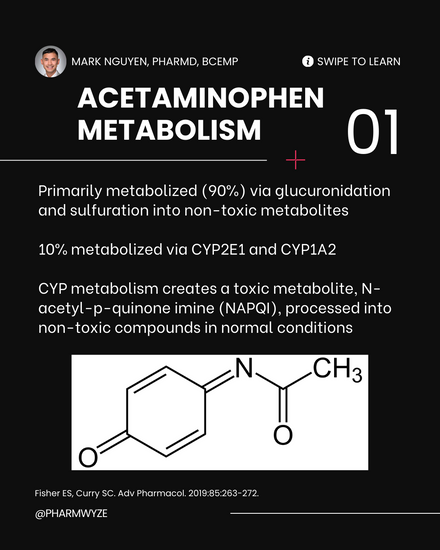Acetaminophen Toxicity: Mechanism of N-acetyl-p-benzoquinone imine (NAC) - #MEDSHED
- Mark Nguyen, PharmD, BCEMP

- Mar 19, 2024
- 1 min read
Updated: Apr 6, 2024
Welcome to the #MEDSHED! Needing a brief, concise review of clinical pharmacotherapy and disease management? Direct links of reference to content discussed? Look no further than the #MEDSHED series based on infographics and carousel presentations!
💊 Acetaminophen Toxicity: Mechanism of NAC - #MEDSHED
😱 Pharmacy can get really complicated, that’s why you need a drug expert. acetaminophen is money for pharmacology and pharmaceutics basis. Acetaminophen is a common OTC analgesic, but with a narrow therapeutic window, it actually accounts for a significant number of acute liver injuries even at therapeutic doses.
90% is conjugated with glucuronic acid or sulfate into nontoxic compounds and eliminated via the urine. Around 10% goes through the cytochrome pathway, specifically CYP2E1 and CYP1A2, to form a toxic metabolite called N-acetyl,p-benzoquinone imine (NAPQI).
Typically, you have loads of glutathione store to metabolize it NAPQI quickly. The issue comes when you don’t have glutathione stores, you know you doesn’t have glutathione stores in the bank? People with uncontrolled liver disease, such as alcoholic cirrhosis, nonalcoholic fatty liver disease, hepatitis, and drug-induced. You’d be surprised how many medications rely on your liver to function normally to metabolize drugs safely.
⏰ Website: www.pharmwyze.com
Shop: www.pharmwyze.com/shop
Social Links: https://links.pharmwyze.com
DrugQueryInbox Request: https://pharmwyze.hopp.to/drugqueryinbox
Streaming Platforms: https://pharmwyze.hopp.to/podstreams
Patreon: https://patreon.com/PHARMWYZE
Paypal Donation: https://pharmwyze.hopp.to/paypaldonate
PHARMWYZE SITREP Newsletter: https://www.pharmwyze.com/sitrepnewsletter













Comments